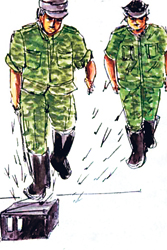It is a small, innocuous-looking wooden box. It could very well pass off as a toy where children hoard seeds or poor women their scraps of jewellery.
But for anyone who comes into contact with this box, it turns out to be a scourge leaving lives shattered. For, although it may not kill that person, it will rip apart one or both of the lower limbs or any part of the body, even leaving the victim blind or deaf.
Jony is its name and in countries, including Sri Lanka, experiencing war, 50% of the casualties fall victim to this small but deadly mine, The Sunday Times understands.
 |
| The little box that can shatter both limbs and lives. |
Dealing with the various devices that ground troops or soldiers would have to face, Consultant Surgeon Dr. Gamini Goonetilleke of the Sri Jayewardenepura General Hospital, groups them into two – explosive devices and bullets which travel at a very high velocity (more than 300 metres per second) from weapons such as AK 47s and T-56s.
Under explosive devices fall bombs, booby-traps, grenades, artillery shells, rocket-propelled grenades, multi-barrel launchers and mines, explains this veteran surgeon who has not only served at Polonnaruwa but also on the battlefront.
Large landmines, sea mines and anti-personnel mines comprise the “mine” category, explains Dr. Goonetilleke, adding that anti-personnel mines have been widely used in the Eelam wars in both the north and the east. “Mine warfare began nearly 20 years ago in 1989 during Eelam War II,” he says, “leading to a large number of soldiers losing their limbs.”
Anti-personnel mines are deemed “effective” not only in causing disabling injuries but also as a psychological deterrent to advancing troops. What impact an anti-personnel mine blast which leaves a brother soldier’s leg a tangled mass of bone and bloody flesh would have on his buddies could only be imagined with horror by those who have never been to the warfront.
Conventional anti-personnel mines are manufactured by arms manufacturers while the other type is produced by terrorist groups, The Sunday Times understands, both equally effective in causing severe disability to anyone who comes into contact with them. Our very own deadly Jony mine, buried just beneath the surface of the ground, is made out of a small block of wood, two pen torch batteries embedded on the bottom part, a detonator, a small quantity of explosives in a cavity, with the box-lid kept slightly open using a rubber band taken from a cycle tube. The moment the lid gets shut through some kind of contact, the electric circuit is complete, with a small electric spark being sent from the detonator to the explosives……..and then there is a boom.
People could set off a Jony by stepping on it while walking, which is the commonest form, sit on it while resting under trees or near wells, lean on it when crawling or slithering towards a target or when handling it during a de-mining process.
 |
| Dr. Gamini
Goonetilleke |
The moment a person steps on a Jony, it would blow up the foot which put pressure on it either up to ankle level or even up to calf or thigh level, says Dr. Goonetilleke. The explosion would also spray shrapnel such as wood and metal fragments, causing injury to the other leg and also the genitalia, while even other soldiers walking behind the victim could have shrapnel embedded in their bodies.
If someone sits on a Jony, the buttocks, rectum, bladder, genitalia, pelvic bone, hip bone and spine could get blown off while if it’s a crawler any part of the body including the stomach could be blasted.
The hands, face, eyes, chest and abdomen could get affected if the person has been attempting to defuse the Jony and it goes off, he explains.
Once a Jony blows up and a soldier is lying in agony, with a shattered limb, what has to be done?
The immediate need would be to stop the bleeding or haemorrhaging, says Dr. Goonetilleke, explaining that on the field at the site of the blast, the other soldiers should use the “field dressings” of gauze and crepe bandages they carry in their packs to apply pressure on the wound. The limb should also be elevated.
Then it would be the difficult task of the small groups of three or four soldiers including the victim’s buddy operating at the battlefront to carry the victim to a first-aid spot on the field. Here a Registered Medical Practitioner would be available for further first-aid. If there is a trained medical technician, a drip could also be started and the victim taken, if available, by vehicle, to Brigade Headquarters, where hopefully a helicopter could airlift him to the nearest hospital which can provide primary surgical care.
From the battlefront the closest such hospital (Mannar, Palali, Vavuniya, Anuradhapura and Polonnaruwa) may be about 50 km away, The Sunday Times understands.
Time is of essence, stresses Dr. Goonetilleke, as ideally a victim of an anti-personnel mine should be in hospital within six hours of sustaining the injury.
However, The Sunday Times learns from other sources that the time would vary depending on the facilities available. Even transport varies from army truck to tractor to CTB bus, it is understood.
At the hospital, the medical team would ensure that the patient is not haemorrhaging, carry out tests such as X-rays, resuscitate him if necessary, relieve the pain, begin antibiotics, give the tetanus toxide and if the victim is in shock begin intravenous infusion of saline and blood, says Dr. Goonetilleke.
Once the patient’s condition is stable, he would be taken to the operating theatre and under anaesthesia, a tourniquet tied above the knee before the dressing is removed. The limb would then be shaved and “irrigated” (washed) with a lot of saline, with the surgeon deciding at what level the limb should be amputated (10-12 cms below the knee joint need to be left for a prosthesis to be fitted). “It has to be amputated at a higher level to where there is healthy tissue,” stresses Dr. Goonetilleke, adding that around 80% of Jony victims would have amputations below the knee.
Healthy tissue would be indicated by the colour (red), bleeding and contracting muscles. Before the amputation all “foreign bodies” such as pieces of boot, metal, sand, small stones, grass and clothing embedded in the tissue along with dead and contaminated tissue need to be removed.
A word of advice comes from Dr. Goonetilleke – after a below-the-knee amputation, it is of vital importance for the patient’s management that the two flaps of the amputation stump not be sutured together, but kept open. “Seven to 10 days later, the patient needs to be taken back to the operating theatre, and only if the flaps are red and bleeding, the muscle is contracting to indicate that it is healthy, should the suturing be done. If not, once again the dead tissue needs to be removed. Otherwise it could lead to a bad infection and delay in rehabilitation.”
 |
| One way of setting off a Jony: Stepping on it while walking |
It would take another 10 days to remove the sutures, with exercises and physiotherapy for that limb being started to ensure that the knee joint is mobile and the muscles are strong. The other limb should also be able to bear the weight, allowing the patient to walk on a crutch.
Dealing with the importance of psychological rehabilitation, he says some patients get “phantom-limb pain” even though their limb is no more and there have been instances where they attempt to get off the bed or imagine excruciating pain of the limb.
While it is essential for a psychiatrist or a psychologist to see them, even other doctors must keep talking to them, he says. “Relations should come see them and they must not be isolated on any account.”
The final stage of recovery would be getting an artificial limb – the patient needs to go to a rehabilitation centre, get measured and a limb custom-made for him, fitted and taught to walk.
The ultimate follow-up would be either re-employing them in the army itself, not on active duty, or else finding them economically viable work in their own villages.
Ironically, it only costs US$ 3 (just over 300 rupees) to make a Jony mine while the rehabilitation of one of its victims, a long and tedious process, would amount to Rs. 1 million, The Sunday Times learns.
And when the war ends, hapless civilians, who have now left their homes but would certainly go back, would face the spectre of Jony mines. Called the “greatest violator of international humanitarian law” by international agencies, the humble woman who goes to gather firewood, the little child who plays with a hitherto “unknown” toy or the farmer who walks to his cultivations could very well be the next victims of the Jony.
 |
| Another way of setting off a Jony: leaning on it while crawling |
“They are blind weapons that cannot distinguish between the footfall of a combatant from that of a non-combatant. They recognize no ceasefire and would kill and injure long after the hostilities have ended,” says Dr. Goonetilleke.
De-mining, public awareness in the form of mine-risk education and clear demarcation of ‘No-go Zones’ with skull and cross-bones would be crucial to prevent history in such countries as Cambodia, Angola, Nicaragua and Afghanistan, being repeated in our own land.
That would be the only answer to the wrath of this man-made epidemic.
Ottawa Treaty or Mine Ban Treaty
A counter to the perils of anti-personnel mines has come in the form of the Ottawa Treaty or Mine Ban Treaty (Convention on the Prohibition of the Use, Stockpiling, Production and Transfer of Anti-Personnel Mines and on their Destruction).
The treaty signed/accessioned by 158 countries as of 2007 has not been signed or ratified by Sri Lanka along with countries such as the United States of America, China, India and Russia.
In the ‘Landmine Monitor Report 2006 – Toward a Mine-Free World’ which had a separate section on Sri Lanka, the Sri Lankan government had estimated that a million landmines were laid in the country by both sides (the other being the LTTE), while the LTTE quoted double that number.
|




